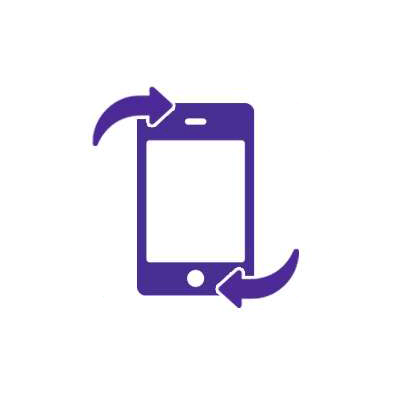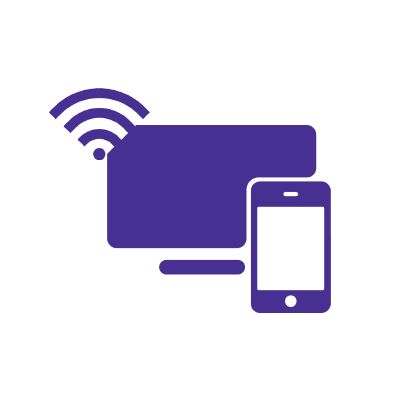What age should you get your kid a phone?

With kids as young as eight now owning phones, parents face a tough choice: When is the right time to give a child a phone? According to a 2021 survey, 31 percent of 8-year-olds owned a smartphone, up from 11 percent in 2015. Determining the right age for a child’s first phone represents a modern parenting dilemma as parents balance online safety, peer pressure and their child’s individual needs.
This article addresses common parental concerns regarding giving a cell phone to a child, explores how to determine the appropriate age and provides practical tips focusing on cybersecurity awareness and online safety.
By the end, you’ll have the clarity and confidence to determine when your child is ready for their first phone.
Switching is easy
Switch & Save
Getting started with Astound is easy: just bring your phone or find a new one, pick a plan and add internet.

The risks of early phone ownership
As parents consider whether to give their child a phone, understanding the potential risks is crucial. Early phone ownership can expose children to various threats that jeopardize their safety, mental health and social development. Here’s why you should take child safety and phone use seriously:
Cybersecurity threats
Children equipped with phones are vulnerable to various cybersecurity threats, with risks including:
-
- Cyberbullying: With the rise of social media and messaging apps, kids become targets of cyberbullies, resulting in emotional distress, depression and social isolation.
- Online predators: Predators may target children by exploiting vulnerabilities in messaging and social media apps popular among kids. For example, apps without adequate privacy measures may disclose children’s whereabouts, such as Snapchat’s Snap Map, which uses your location data to display your location and your friends’ locations.
- Exposure to inappropriate content: Without strict parental controls, kids may encounter explicit or violent material online.
- Identity theft and phishing scams: Unsecured apps and phishing scams, such as malicious gaming apps or emails and texts with harmful links, can compromise their personal information, leading to identity theft and privacy violations.
Mental health and screen time
Excessive screen time due to phone use poses serious risks to children’s mental health and well-being. According to studies from the American Academy of Child & Adolescent Psychiatry, children between the ages of 8 and 12 spend an average of four to six hours per day in front of screens.
Such constant exposure can increase vulnerability to risks such as anxiety, stress and depression. Additionally, the blue light emitted by screens can disrupt their sleep patterns, potentially harming their cognitive development and academic performance.
Social pressures
The phrase “everyone else has one” is a common refrain among children, expressing the social pressure to have a phone. While phones can help children stay connected, they may also reduce face-to-face interactions and negatively impact their development of essential social skills, communication and emotional intelligence.
Furthermore, peer pressure and social media feed the cycle of comparisons through likes on social media posts and the number of followers. This pressure can impact their self-esteem and heighten their need to fit in.
See how much you can save
Save with Astound
Check out our savings calculator to see the change in your bill when you build a plan with Astound.

Finding the right age: A balanced solution
Deciding at what age your child should get their first smartphone is a nuanced decision that requires consideration of their safety, benefits, challenges, needs and readiness. Here is a balanced framework to help guide parents in choosing the right time to give their child a phone.
What the data says
Studies suggest that middle school is the most popular time for children to own their first phone. According to Stanford Medicine, the average age at which children receive their first phone is 11.6 years, while the American Academy of Pediatrics notes that most children get their phones between the ages of 12 and 13.
While these statistics provide a helpful baseline showing how early kids embrace technology, your child’s unique situation matters more than the average statistics.
Pros of early phone ownership
Children owning phones at an early age provides several advantages:
- Safety and security: Phones equipped with GPS tracking and location-sharing features offer peace of mind to parents who want to know their children’s location.
- Educational apps: Smartphones can be learning tools, providing educational resources for help with homework and interactive educational experiences.
- Family communication: Phones make staying in touch with family and friends easier, especially during emergencies.
Cons to consider
Despite the clear advantages, there are downsides to consider:
- Distraction: Phones can disrupt children’s attention, interrupting their studies and focus. This distraction can negatively affect their academic performance.
- Addiction and dependency: Overuse of social media apps and excessive screen time can lead to unhealthy digital habits, such as phone dependency, staying up late and reduced physical activity.
- Exposure to risks: Without proper parental control and oversight, kids may encounter cyber threats such as cyberbullying, predators like social media impersonators or inappropriate content.
Maturity matters
Experts agree that it’s not about a child’s particular age but their maturity, social awareness and understanding of technology. To evaluate whether your child is mature enough to own a phone, consider the following traits:
- Responsibility: How often do they lose or carelessly handle their belongings like toys and books?
- Social awareness: How easily do they pick up social cues? This skill is essential when navigating online interactions and challenging social situations.
- Decision-making: Do they demonstrate thoughtful decision-making, especially when facing social pressure or difficult choices?
If your child shows such traits, they might be ready for a phone earlier than others. Otherwise, encourage such habits before handing them their first phone.
Readiness checklist
To help determine whether your child is ready for their first smartphone, ask yourself the following essential questions:
- Can your child consistently follow the rules and limits to phone use?
- Can they manage duties (e.g., chores or homework) without frequent reminders?
- Do they understand basic internet safety, like avoiding sharing personal information or talking to strangers online?
- Do they need a phone for practical reasons like school coordination and communication, or do they want one solely due to peer pressure?
- Is your child open to discussing uncomfortable or concerning interactions with you?
- Have you set any clear expectations regarding phone usage and screen time?
- Do they understand the consequences if they violate the phone usage guidelines?
If you can confidently answer “yes” to most of these questions, your child is likely ready to use a phone. If you are unsure or respond “no” to most of them, consider waiting until your child shows maturity and responsible traits.
Network & Coverage
Astound's got you covered
Our mobile service runs on a nationwide network with 5G service in all 50 states giving you reliable nationwide coverage you can count on.

Choosing the right phone for your child
Choosing the right phone involves balancing functionality, safety and age appropriateness. Consider the following factors to help you choose wisely.
Phone types
Different phone types are available to match the child’s age, maturity and needs:
-
- Smartphones: These are full‑featured devices that provide internet access, apps and social media. They are ideal for older, more responsible kids but require strict parental controls to ensure safe usage.
- Basic phones: Also known as “dumb phones,” they offer call and text features only. An example is the Nokia 3210.
- Kid‑friendly phones: These devices are designed for kids and offer built‑in safety features, such as limited internet access, pre-approved apps, parental controls and GPS tracking. Popular brands include Gabb, Bark, Pinwheel and Troomi phones.
Safety features
Prioritize mobile phone security when selecting a phone for your child. To ensure optimal protection for your child’s phone, consider the following safety features:
-
- Parental control: This feature allows you to limit and monitor your child’s online activity, filter content and track screen time. Smartphones require third‑party parental control apps, while kid-friendly phones have built-in options.
- Limited internet access: Restricting or blocking internet access minimizes exposure to harmful content. Kid‑friendly phones restrict internet browsing, while basic phones have no internet access.
- GPS tracking: Real-time location tracking with apps like Find My Phone ensures parents can monitor their children’s whereabouts.
- Contact management: Does the phone offer the functionality to control who the child communicates with?
- Battery life: Prioritize phones with batteries designed to last a full day of use to ensure they are reachable and can communicate throughout the day.
Cybersecurity checklist
Implement the following phone security practices to ensure your child’s phone usage is secure:
-
- Disable app downloads by default to prevent unauthorized downloads or the risk of downloading malware.
- Use strong passwords and passphrases to protect the devices.
- Enable multi‑factor authentication for added account security.
- Set up privacy settings to prevent data sharing.
- Regularly update the phone’s software to receive security updates and patches.
Learn more: Explore devices and options at the Astound Mobile Shop.

Setting rules and boundaries
Once your child receives their first phone, it is crucial to establish clear rules and boundaries to encourage safe and responsible phone use.
Establishing guidelines
Providing guidelines on phone usage helps your child understand acceptable phone behavior while developing healthy habits. Consider implementing the following rules:
-
- Time limits: To prevent excessive phone use, set screen time limits and designate specific hours for phone use, such as after homework or during certain times of the day.
- No-phone zones: Establish phone-free areas or times, such as meal times, bedtime or when completing homework, to encourage healthy sleeping habits and face-to-face interactions.
- Content restrictions: Use built-in parental controls or third-party apps to filter inappropriate websites, apps and games.
Teaching digital safety
Aside from setting phone rules, educate your children about digital citizenship and cybersecurity awareness to promote responsible habits and online safety.
Consider lessons such as:
-
- Privacy awareness: Teach them about privacy, protecting their personal information (name, address and phone number) and avoiding oversharing online.
- Avoiding strangers: Explain the risks of talking to strangers online and how they should respond when contacted by someone unknown.
- Responsible texting: Emphasize the importance of responsible texting, how to talk to others and the potential consequences of irresponsible online interactions.
- Phishing scams: Teach them how to recognize and avoid phishing scams. Show them how to identify suspicious texts, emails or unfamiliar messages on social media to avoid potential traps.
To reinforce your child’s understanding of digital safety, explore kid-friendly cybersecurity resources like KnowBe4, PBS Nova Labs and the K-12 Computer Science Framework. These interactive platforms teach online safety in a fun and engaging way.
Monitoring use
Monitoring your child’s online activities ensures their safety while acknowledging their growing independence.
To keep tabs on them effectively:
-
- Conduct regular check-ins and encourage open conversations about their online interactions to foster trust and accountability.
- Use built-in parental control features or third-party apps like Qustodio or Google Family Link to track usage, set screen limits and restrict access to certain features.
- Periodically review the devices and apps’ privacy settings and make adjustments to minimize risks of privacy breaches.
- Watch out for any behavioral changes, such as distractions, isolation or dependency, to address them proactively.
- Opt for a family cell phone plan if your child has access to the internet. Many carriers offer family cell plans with shared data limits to track usage and security features such as spam blocks and parental controls to ensure safety.
Monitoring is about guidance, not control. Implementing these strategies helps your child learn to use their phone wisely while prioritizing online safety.
Learn more: Get affordable, family-friendly mobile plans at Astound Mobile.
Mobile + Internet + TV
Switch to Astound
Get Astound Mobile, Internet and TV—and save on the best services available.

Conclusion
There’s no universal “right age” for your child’s first phone. Instead, the decision depends on your child’s maturity, specific needs and readiness for the added responsibility.
Ask yourself, “What is my child’s biggest phone need?” Then, thoughtfully weigh the pros and cons of early phone ownership, implement clear safety measures and establish practical guidelines they must follow.
Communicate openly with your child about digital safety, responsibilities and expectations regarding phone ownership. Use the tips and insights in this guide to help you make thoughtful and informed decisions that are best for your child.
Frequently asked questions
Is it OK for an 11-year-old to have a phone?
Whether your 11-year-old is ready to have a phone depends on their ability to handle responsibilities, understand consequences and follow the rules. While some 11-year-olds are ready, others may require more time.
Do most 12-year-olds have phones?
Yes, most 12-year-olds do have phones. The data varies but research from Stanford Medicine indicates that the average age at which children receive their first phone is 11.6 years, with the trend increasing as they grow older.
What age is the right age to get a phone?
There is no universal “right age” for a child to get a phone. The timing depends on your child’s level of maturity and responsibility. However, research from the American Academy of Pediatrics shows that most children receive their first phones between 12 and 13 years old.
Can a 7-year-old have a mobile phone?
While a 7-year-old can technically have a mobile phone, evaluating their readiness for owning one is essential. For younger kids, a basic phone for calls and texts or a kid-friendly phone might be more suitable than a smartphone.
What percent of 8-year-olds have phones?
According to Statistica, approximately 31% of 8-year-olds owned a phone in 2021. This statistic shows that the trend is leaning toward younger children having phones. However, parents should implement strict parental controls and guidelines to ensure safety and appropriate use.
Get Mobile + Internet Together
Find the mobile service, home internet and streaming that’s just right for you.
*Internet speeds may vary & are not guaranteed. Certain equipment may be required to reach advertised speeds. DOCSIS 3.1 modem with 2.5GE physical LAN port is required for 1 Gigabit speeds and higher. See astound.com/yourspeed for why speeds may vary. To view Astound’s FCC Network Management Disclosure see astound.com/policies-disclaimers. Limited time offer, subject to change without notice. Advertised promotional price valid for duration of the stated promotional period from time of service activation. Regular rates apply after promotional period ends. Equipment not included and is extra. Modem required for Internet service. Enhanced Wi-Fi or Whole Home Wi-Fi (eero) not included and is add’l. Offer includes a monthly discount for enrollment in both automatic payments (autopay) & paperless billing (e-bill). Discount of $10 applies with automated bank account deduction or a discount of $5 applies with automated credit/debit card payment. Valid email address required. Must complete enrollment in autopay and e-bill within 30-days of placing the order. Without enrollment, the discount does not apply. Discount appears on bill within 3 bill cycles after enrolling. If either autopay or e-bill is canceled, services are changed, or the account is not in good standing, then the monthly discount will be discontinued. Offer valid only for new residential Astound customers or previous customers with an account in good standing who have not had Astound service within the last 60 days. Any add’l services, equipment, premium channels & other tiers of service are subject to an add’l charge & regular increases. A one-time activation fee of $14.99 (in addition to any installation fees) will be charged & is subject to change. Add’l fees apply for taxes & surcharges, and are subject to change. WA RESIDENTS: unless otherwise specified, price does not include a 2% Regulatory Administration Fee. For details about taxes, fees & surcharges visit astound.com/fees. No early termination fees apply in the event service is terminated in advance of the promotional end date. Customer is responsible for any accrued service charges in the event service is canceled. Subject to credit check. Not all services & speeds are available in all areas. A multi-product discount may be available to qualifying addresses with a subscription to mobile, TV, and 600 Mbps Internet or higher. Discounts will be reflected in your order cart at time of purchase, if available. Other restrictions may apply. All services are governed by the Astound Customer Terms & Conditions that can be found at astound.com/policies-disclaimers. © 2025 Radiate HoldCo, LLC d/b/a Astound Broadband. All rights reserved.
While we have made every attempt to ensure that the information contained in this site has been obtained from reliable sources, Astound is not responsible for any errors or omissions, or for the results obtained from the use of this information. All information in this site is provided “as is”, with no guarantee of completeness, accuracy, timeliness and without warranty of any kind, express or implied, including, but not limited to warranties of performance, merchantability and fitness for a particular purpose. Certain links in this site connect to other websites maintained by third parties over whom Astound has no control. Astound makes no representations as to the accuracy or any other aspect of information contained in other websites.
eero Plus is available for an additional $9.99/month and requires subscription to whole home WiFi powered by eero.

















